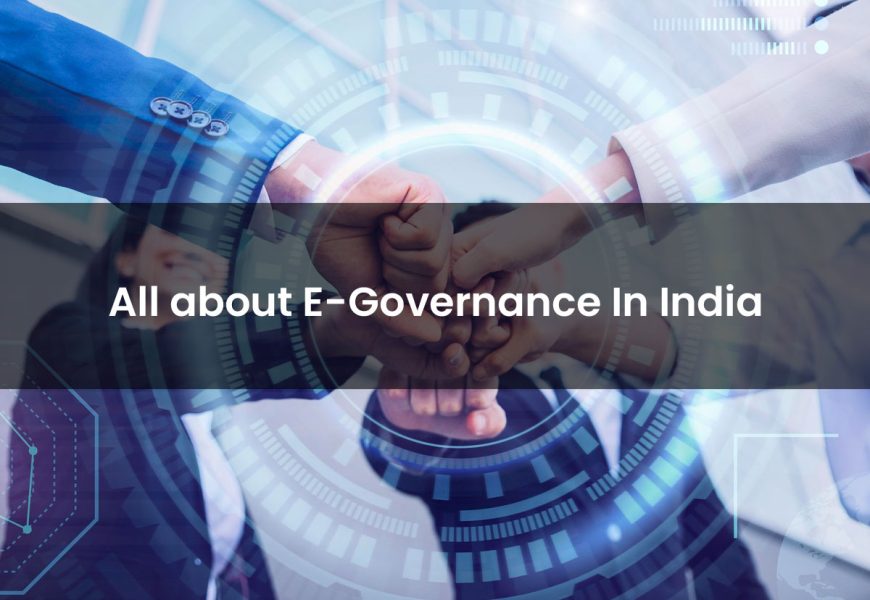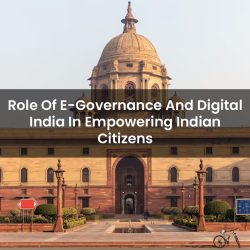E-Governance in India is not a new concept, and it has been in the works for quite a while. There have been multiple initiatives undertaken by the Central as well as State Governments to welcome an era of digitisation. There have been efforts to perfect this mode of delivery in public services at multiple levels.
The National e-Governance Plan (NeGP) stemmed from the computerisation of all departments in the government. This has now grown into a system that plans initiatives to tackle the more niche points of governance like transparency, citizen centricity, and service orientation.
This article will be taking a deeper dive into the inception of e-governance, its benefits, implementation, and much more. We shall also be giving our two cents about what can be done to refine and fine-tune the process.
What is e-Governance in India?
Before we discuss e-Governance in India, let us discuss and understand what e-Governance comprises of. Electronic governance or e-governance is a system where the government functions with Information and Communications Technology (ICT). All provision of government services, exchange of information, existing document integration and transactions are done through an electronic medium.
E-governance in India has been adopted with the aim of being SMART. SMART is an acronym that stands for a government that is ‘Simple’, ‘Moral’, ‘Accountable’, ‘Responsible’, and ‘Transparent’.
SMART Governance
Smart Governance, as defined by IGI Global, entails employing technology and innovation to empower governing bodies to make informed decisions and facilitate planning processes.
It is closely tied to enhancing democratic processes and revolutionising the delivery of public services. Through Hello Lamp Post, our emphasis lies in refining the delivery of public services and providing valuable insights to governing bodies through our inventive and engaging solutions. The significance of Smart Governance is increasingly acknowledged as an essential component of smart cities, fostering a robust connection between governments and their citizens.
In the Indian context, SMART is an acronym that stands for governance, which is ‘Simple’, ‘Moral’, ‘Accountable’, ‘Responsible’, and ‘Transparent’. Let’s take a look at the individual meanings and objectives of these words:
- “S” stands for simplicity, indicating the simplification of governmental rules, regulations, and processes through the utilisation of Information and Communication Technologies (ICTs), fostering a user-friendly government.
- “M” represents morality, signifying the emergence of a new ethical value system within the political and administrative machinery. Technological interventions enhance the efficiency of anti-corruption agencies, police, judiciary, and other institutions.
- “A” denotes accountability, which entails the design, development, and implementation of effective Management Information Systems and performance measurement mechanisms to ensure the accountability of public service functionaries.
- “R” stands for responsiveness, emphasising the streamlining of processes to expedite service delivery and enhance the system’s responsiveness to citizen needs.
- “T” signifies transparency, encompassing the dissemination of government information to the public domain and the promotion of transparent processes and functions. This transparency fosters equity and upholds the rule of law in the responses of administrative agencies.
Origin of e-Governance in India
E-Governance in India traces its roots back to the 1970s, primarily concentrating on internal government applications such as defence, economic monitoring, and the utilization of ICT for managing data-intensive functions such as elections, census, and tax administration.
The inception of the Department of Electronics in 1970 marked a significant milestone in India’s e-governance journey, spotlighting the importance of information and its communication.
In 1977, the establishment of the National Informatics Centre (NIC) further propelled e-governance efforts with the initiation of the District Information System program, aiming to computerise district offices nationwide.
A pivotal moment arrived in 1987 with the launch of NICNET, the national satellite-based computer network, which served as a cornerstone for advancing e-governance initiatives across the country.
Different Connotations of e-Governance
There are multiple connotations of e-governance. We have listed them below:
- E-Administration: ICTs were utilised to modernise governmental operations, including establishing data repositories for Management Information Systems (MIS) and computerising various records, such as land and health data.
- E-Services: Focusing on enhancing citizen-state interaction by providing online services. Examples include the provision of various government services through digital platforms. E-administration and e-services collectively form what is commonly known as e-government.
- E-Governance: Employing IT to enhance the government’s capacity to meet societal needs. This encompasses publishing policy and program-related information for citizen engagement, strategic planning using IT, and pursuing government development objectives.
- E-Democracy: Harnessing IT to enable broad societal participation in governance. Its focus lies in fostering transparency, accountability, and citizen involvement through measures such as online policy disclosures, grievance redressal mechanisms, and e-referendums.
Kinds of Interactions in e-Governance
There are 4 types of interactions that can happen in e-governance.
G2C (Government to Citizens)
This interaction happens between the government and the citizens. It enables the citizens to access a wide variety of public services efficiently. The electronic process makes it more accessible for everyone. The primary aim here was to make e-governance super citizen-friendly.
G2B (Government to Business)
This form of interaction allows the business community to contact the government through e-governance tools. The main objective behind its inception was to avoid red-tapism, which will help and reduce the usage of resources and save time as well. This would also help facilitate a more transparent environment for businesses that deal with the government. Licensing, permits, revenue collection and procurement are aided by such G2B initiatives.
G2G (Government to Government)
This type of interaction facilitates smooth communication between different government bodies, whether it’s within departments and agencies or between different levels of government (e.g., central and state governments or between states).
The main objective is to enhance efficiency, performance, and overall output.
G2E (Government to Employees)
This kind of interaction involves communication between the government and its employees. Utilising ICT tools streamlines these interactions, making them quicker and more efficient, consequently boosting employee satisfaction levels.
Why Should We Pick E-Governance?
Embracing e-governance can greatly benefit governments seeking to modernise their administrative processes. Digitising operations helps e-governance to streamline decision-making and enhance service delivery, leading to increased government efficiency. Moreover, it promotes transparency by making information readily accessible to the public, fostering trust and accountability in governance.
Cost savings are another significant advantage of e-Governance. Through the automation of tasks and reduction in paperwork, governments can optimise resource allocation and achieve more with limited financial resources. Additionally, e-governance prioritises citizen empowerment by providing convenient access to government services and information, thereby enhancing citizen participation in governance processes.
Furthermore, e-governance facilitates better government-business interactions, creating a conducive environment for economic growth. It fosters innovation and entrepreneurship, contributing to sustainable development and prosperity. Moreover, embracing e-governance reflects a commitment to modernising government practices and leveraging technology for the public good, paving the way for agile, responsive, and future-ready administrations.
The adoption of e-governance is essential for governments looking to stay relevant and effective in the digital age.
Advantages of e-Governance
There are multiple benefits to opting for e-governance. Let’s discuss them in some detail below:
- Enhanced Delivery and Efficiency of Government Services: Efficient delivery of government services is ensured through the use of digital platforms under e-Governance initiatives. By streamlining processes, bureaucratic delays are minimised, thereby enhancing overall efficiency.
- Better Government Interactions with Business and Industry: e-Governance fosters better communication and collaboration between government bodies and businesses. This facilitates smoother regulatory processes, ultimately creating a conducive environment for economic growth and development.
- Citizen Empowerment through Access to Information: e-Governance provides citizens with easy access to information, empowering them to make informed decisions. Increased transparency in government operations enhances trust and accountability within society.
- Enhanced Government Management: Digital tools enable better management of government resources and personnel under e-governance frameworks. Decision-making processes become more data-driven and responsive to citizen needs.
- Reduction in Corruption: The transparent nature of e-governance mechanisms helps in minimising opportunities for corruption. Digital trials and accountability measures deter malpractice within the administration.
- Increased Transparency in Administration: e-Governance initiatives promote transparency by making government processes and decisions accessible to the public. This fosters trust and legitimacy in governmental actions.
- Greater Convenience to Citizens and Businesses: Online services offered through e-Governance platforms enhance convenience for citizens and businesses. Transactions become quicker and more accessible, reducing the hassle of traditional bureaucratic procedures.
- Cost Reductions and Revenue Growth: e-Governance leads to cost savings through the automation of processes and reduction in paperwork. Additionally, improved efficiency and effectiveness contribute to government revenue growth.
- Increased Legitimacy of Government: By promoting transparency, efficiency, and citizen engagement, e-governance enhances the legitimacy of government institutions. Citizens perceive the government as more accountable and responsive to their needs.
- Organisational Flattening: e-Governance flattens organisational structures by reducing hierarchical barriers. This encourages faster decision-making and promotes a more agile administrative setup.
- Reduction in Paperwork and Red-tape: Digitalization of administrative processes minimises paperwork and bureaucratic hurdles. This leads to smoother coordination between different levels of government, fostering better planning and execution of policies.
- Improved Relations with Civil Society: e-Governance initiatives facilitate better engagement and collaboration between public authorities and civil society organisations. This promotes participatory governance and strengthens the government’s and its citizens’ bond.
Initiatives Under E-Governance in India
There have been multiple plans and schemes under e-governance in India. Here is a brief list of these initiatives.
National Initiatives
- Establishment of Task Force and Ministry: India laid the foundation for e-governance with the establishment of a National Task Force on Information Technology and Software Development in 1998. This initiative was followed by the creation of the Ministry of Information Technology in 1999, which was dedicated to spearheading e-governance efforts at the central level.
- Formulation of Agenda and Enactment of IT Act: In 2000, a 12-point agenda was formulated for the implementation of e-Governance across central ministries and departments. The same year witnessed the enactment of the Information Technology Act, providing a legal framework to support e-Governance endeavors, with subsequent amendments in 2008.
- National Conference and NISG Establishment: The first National Conference of States’ IT Ministers convened in 2000 aimed at devising a Common Action Plan to advance IT adoption nationwide. Additionally, the establishment of the National Institute for Smart Government (NISG) further bolstered e-Governance capabilities.
State-Level Initiatives
- Bhoomi Project (Karnataka): The Bhoomi Project in Karnataka pioneered e-governance by providing rural land records to farmers. This initiative computerised around 20 million land records, facilitating efficient land-related information management.
- KHAJANE (Karnataka): KHAJANE, a government-to-government initiative in Karnataka, automated the state’s treasury system to improve state finances and eliminate manual inefficiencies.
- E-Seva (Andhra Pradesh): e-Seva in Andhra Pradesh aims to deliver government and business services directly to citizens online, enhancing convenience and accessibility for citizens.
National Programs and Plans
- National e-Governance Plan (NeGP): Launched in 2006, NeGP comprised 31 Mission Mode Projects (MMPs) and 8 support components. It drove e-government initiatives nationwide and promoted efficient and transparent governance.
- National Policy on Information Technology (NPIT): The adoption of NPIT in 2012 provided a strategic framework to guide India’s e-Governance efforts, reaffirming the country’s commitment to harnessing technology for socio-economic development.
What is the National e-Governance Plan (NeGP)?
The National e-Governance Plan (NeGP) serves as a comprehensive framework for e-Governance initiatives across India. This plan encompasses a vast countrywide infrastructure that extends to even the most remote villages, facilitating large-scale digitisation of records. The objective is to ensure easy and reliable access to the Internet, thereby empowering citizens with digital services and information.
Building upon the foundation laid by NeGP, the Government has proposed the implementation of “e-Kranti: National e-Governance Plan (NeGP) 2.0” as part of the Digital India programme. This initiative aims to further enhance e-Governance capabilities by leveraging emerging technologies and innovative approaches. Through e-Kranti, the government seeks to streamline administrative processes, improve service delivery, and promote inclusive growth by harnessing the power of digital technologies.
Digital India
Digital India is a comprehensive program initiated by the Ministry of Electronics and Information Technology (MeitY) aimed at preparing India for a knowledge-based transformation. It integrates a multitude of ideas and initiatives under a unified vision to propel the nation towards digital empowerment and inclusive growth.
Vision Areas
- Digital Infrastructure as Utility to Every Citizen: Ensuring access to digital infrastructure and services as essential utilities for all citizens.
- Governance and Services on Demand: Providing government services and information to citizens on demand through digital platforms.
- Digital Empowerment of Citizens: Empowering citizens through digital literacy, access to information, and participation in governance processes.
Various Initiatives
- MyGov is a platform that facilitates citizen-government interaction and participation in governance through various activities such as discussions, polls, blogs, etc.
- DigiLocker: An online platform enabling citizens to store and share documents electronically and securely with service providers.
- E-Hospital-Online Registration Framework (ORF): This framework facilitates online appointments with government hospitals and streamlines patient care and medical record management.
- National Scholarships Portal (NSP): A centralized platform for scholarship application and disbursement to students under various schemes.
- DARPAN: An online monitoring tool for analysing the implementation of state projects and presenting real-time data on key performance indicators.
- PRAGATI (Pro-Active Governance And Timely Implementation): A system aimed at ensuring proactive governance, transparency, and accountability in project implementation.
- Common Services Centres 2.0 (CSC 2.0): ICT-enabled kiosks provide government and private services in rural areas, enhancing citizens’ digital access.
- Mobile Seva: Delivering government services to citizens through mobile phones and tablets, increasing accessibility and convenience.
- Jeevan Pramaan: Aadhaar-based biometric authentication system for pensioners, ensuring the authenticity of digital life certificates.
- National Centre of Geo-informatics (NCoG): Development of a GIS platform for sharing, collaboration, and decision support in government departments.
e-Kranti
E-Kranti, or the National e-Governance Plan 2.0, is a pivotal component of the Digital India initiative, approved in 2015 with the vision of “Transforming e-Governance for Transforming Governance.” This ambitious plan encompasses 44 Mission Mode Projects, each at various stages of implementation, aimed at revolutionising governance through digital means.
Thrust Areas of e-Kranti
- e-Education: Connecting all schools to broadband and providing free WiFi in secondary and higher secondary schools, benefiting approximately 250,000 schools.
- PMGDISHA: Pradhan Mantri Gramin Digital Saksharta Abhiyaan aims to digitally literate six crore people in rural India.
- SWAYAM: Offering Massive Online Open Courses (MOOCs) to facilitate e-education, allowing access to courses from Class 9 to post-graduation anytime, anywhere.
- E-Healthcare: Encompassing online medical consultation, medical records management, medicine supply, and pan-India exchange of patient information.
- Farmers: Providing real-time price information, online input ordering, and facilitating mobile banking for cash, loan, and relief payments.
- Security: Offering mobile-based emergency and disaster-related services in real-time to minimise loss of lives and properties.
- Financial Inclusion: Strengthening financial inclusion through mobile banking, Micro-ATM program, and leveraging Common Service Centers (CSCs) and Post Offices.
- Justice: Strengthening the Interoperable Criminal Justice System by integrating applications like e-Courts, e-Police, e-Jails, and e-Prosecution.
- Planning: Implementing the National GIS Mission Mode Project to facilitate GIS-based decision-making for project planning and development.
- Cyber Security: Setting up the National Cyber Security Co-ordination Centre to ensure a safe and secure cyber-space within the country.
Objectives of e-Kranti
The primary objectives of e-Kranti include:
- Redefining NeGP with transformational and outcome-oriented e-governance initiatives.
- Enhancing the portfolio of citizen-centric services.
- Ensuring optimum usage of core Information & Communication Technology (ICT).
- Promoting rapid replication and integration of e-Governance applications.
- Employing emerging technologies and adopting more agile implementation models.
Mission Mode Project
A Mission Mode Project (MMP) is an integral component of the National e-Governance Plan (NeGP), designed to address specific aspects of electronic governance within a defined timeframe. Each MMP focuses on enhancing government services in a particular domain, such as banking, land records, or commercial taxes, among others.
Key Features of MMPs
- Clear Objectives: MMPs are characterised by clearly defined objectives, scopes, and desired outcomes. These projects aim to streamline and improve government services in their respective domains.
- Scope: Each MMP operates within a defined scope, focusing on specific areas of electronic governance. This ensures targeted efforts and efficient resource utilisation.
- Implementation Timelines: MMPs adhere to predetermined implementation timelines, ensuring the timely execution of project activities. This helps in achieving project milestones and delivering benefits to stakeholders within stipulated timeframes.
National Conference on e-Governance
The National Conference on e-Governance, organised annually by the Department of Administrative Reforms and Public Grievances (DARPG) in collaboration with the Department of Information Technology and a state government, serves as a premier platform for senior government officials, including IT Secretaries from state governments, to convene and deliberate on various e-Governance initiatives.
Key Objectives
- Facilitate Exchange of Views: The conference facilitates the exchange of views, experiences, and best practices among government officials involved in e-Governance implementation.
- Recognition of Excellence: Each year, the Department of Administrative Reforms and Public Grievances acknowledges and promotes excellence in e-Governance by recognising government organisations/institutions that have implemented exemplary initiatives.
Challenges to E-Governance
India, though on a fast pace towards digitisation, faces a few roadblocks. Let’s briefly discuss them.
Infrastructure
The lack of essential infrastructure, such as electricity and internet connectivity, poses a significant challenge to e-governance initiatives. To address this issue, initiatives like BharatNet and Saubhagya have been introduced to enhance infrastructure development and ensure broader access to basic facilities.
Cost
Implementing e-governance measures requires substantial public expenditure, posing a financial challenge, particularly in developing countries like India. The cost factor often acts as a major impediment to the successful implementation of e-governance projects, necessitating careful budgetary considerations and resource allocation.
Privacy and Security
Concerns over data privacy and security have grown following recent incidents of data breaches, undermining public trust in e-governance. To address these concerns, stringent security standards and protocols must be established to safeguard the interests of all citizens and ensure the confidentiality and integrity of sensitive information.
Digital Divide
A significant digital divide persists between users and non-users of e-government services, often along socioeconomic and demographic lines such as income, gender, and urban-rural divide. Bridging this gap is crucial to ensure equitable access to the benefits of e-governance initiatives, necessitating targeted efforts to address disparities and promote inclusivity in digital access and literacy.
What Could Be Done?
- Adopting a Hybrid Approach for Interoperability: Implementing a hybrid approach that combines centralised systems for document, knowledge, file, and grievance management can enhance interoperability among e-Governance applications. This approach ensures seamless data exchange and coordination between various government departments and agencies.
- Tailoring Rural e-Governance Initiatives to Grassroots Realities: It’s imperative to understand and analyse the grassroots realities of rural areas before implementing e-Governance initiatives. Customising solutions to address rural communities’ specific needs and challenges will ensure their effectiveness and relevance.
- Devising Targeted Capacity-Building Mechanisms: The government should focus on devising appropriate and feasible capacity-building mechanisms for different stakeholders, including bureaucrats, rural and urban masses, elected representatives, etc. These mechanisms should aim to enhance digital literacy, skills, and awareness to participate in and benefit from e-governance initiatives effectively.
- Harnessing the Power of Cloud Computing: Cloud computing offers significant potential to enhance the delivery of e-governance services. Besides cost reduction, cloud computing enables the provision of new services, improves the education system, and creates job opportunities. Initiatives like Meghraj-GI Cloud play a crucial role in accelerating e-service delivery and optimising government ICT spending.
- Promoting e-Governance in Regional Languages: Recognizing the linguistic diversity of countries like India, e-Governance initiatives should prioritise offering services in regional languages. This ensures inclusivity and accessibility for citizens from diverse linguistic backgrounds, thereby enhancing their participation and engagement in governance processes.
In Conclusion
E-governance stands as a transformative force, reshaping the landscape worldwide. From streamlining bureaucratic processes to enhancing service delivery and promoting transparency, its impact reverberates across societies, empowering citizens and fostering inclusive development.
As we navigate the digital era, the role of innovative platforms like TankhaPay becomes increasingly pivotal. With its cutting-edge technology and commitment to financial inclusion, TankhaPay embodies the spirit of e-government by revolutionising the way payroll and social security are managed in the digital age.
TankhaPay exemplifies the synergy between e-Governance and financial technology. Book your consultation with us today!
FAQs on e-Governance in India
What are the pillars of e-governance?
The four prominent pillars of e-governance are People, Process, Technology, and Resources. These pillars collectively support the digital transformation of governance.
What are 5 examples of e-governance?
Examples of e-governance initiatives include Digital India, the National Portal of India, the Prime Minister of India Portal, Aadhaar, online tax filing and payment systems, digital land management systems, and online entrance examinations like the Common Entrance Test.
What is the first e-governance project in India?
The first major step towards e-governance in India was the establishment of the National Informatics Centre (NIC) in 1977, followed by the launch of NICNET in 1987. These initiatives laid the foundation for the computerisation of government departments and paved the way for further e-governance projects.
What are the main advantages of e-governance?
The advantages of e-governance include improved delivery and efficiency of government services, enhanced interactions between government and businesses/industry, citizen empowerment through access to information, more efficient government management, reduced corruption, and increased transparency in administration.















